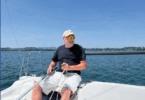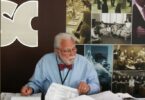PAC World: When and where were you born?
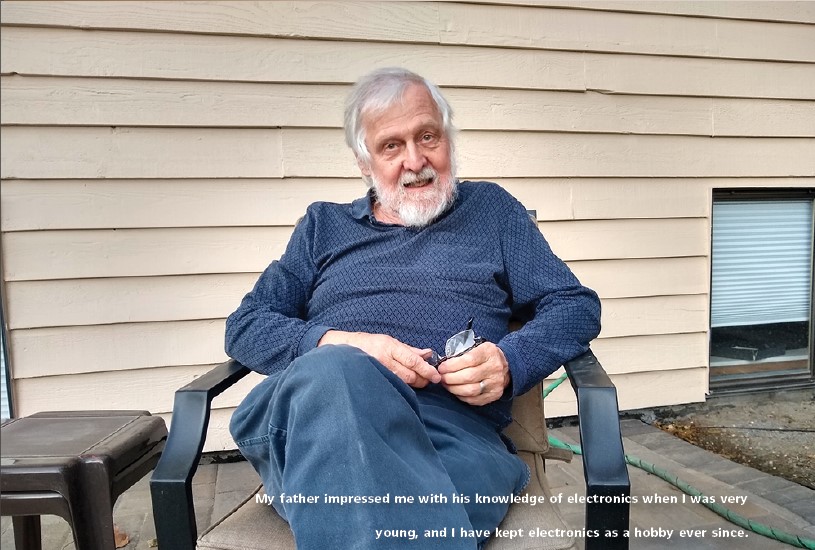
H.K.: I was born in 1943 in Birmingham, England, a large industrial town in the middle of the country.
PAC World: Where did you grow up and where did you go to school?
H.K.: I grew up on what was then the outer southeast edge of the town. My Grammar School (equivalent of high school in the US) was in an ancient building (dating from 1883) near the middle of town.
PAC World: Was there someone in your childhood that influenced your decision to become an engineer?
H.K: My father impressed me with his knowledge of electronics when I was very young, and I have kept electronics as a hobby ever since. He was a teacher for a profession, and did fine woodwork for a hobby.
PAC World: What were your interests while in school?
H.K.: I was in the Radio Club and the Cycling Club. And I got interested in geology on my own, and did a lot of fossil-hunting. I became a fairly serious cyclist, and cycled from England to France to Belgium, the Netherlands and Germany and Denmark, during two successive summers. One trip lasted longer than expected, and I made the papers in the UK because people became worried, I had been kidnapped or something. In fact, all that happened because my postcard (disclosing my plans) never made it home.
PAC World: Where did you go to university and why did you choose that particular one?
H.K.: I went to the Birmingham College of Advanced Technology, which became Aston University while I was there. I got a BSc and an MSc. The schooling was interleaved with practical work as part of a program organized by my employer, the local distribution authority (part of the nationalized power system). I was an Apprentice with them for five years.
PAC World: What did you study and why did you pick that field?

H.K.: I studied Power because that was what the power company was paying me to do. I added Measurement because I found it fascinating.
PAC World: How did you start your career?
H.K.: As an undergraduate studying power, I had the opportunity to do a Senior Project, and chose to build a small HVdc converter, a sort of simulator of a terminal of the real thing. (Hardware simulators were all the rage at the time. Computers had not yet reached the point of putting them out of business.) This allowed me to do some electronics, and some control, and learn about HVdc. Based on that work, I moved to the US, and that’s where my career really started.
PAC World: Why did you move to the United States?
H.K.: There was a brain-drain going on, and one of the students in a class I took at my university was from California. He never expressed any thought that I should or should not go to the US, but he had a quiet conviction that California was just the best place there was.
I applied for a job with Pacific Gas and Electric in San Francisco, and that led to an interview in London with Howard Barnes of AEP, and a job offer to work on an HVdc simulator in Philadelphia with the Edison Electric Institute.
PAC World: What was the reason to continue your education and where did you do it?
H.K.: The job at Edison Electric lasted about a year and a half, and then my wife and I had the chance to review our next move. She was in favor of staying in the US, and I had been invited by Cliff Mosher at the Drexel Institute of Technology to do a PhD. So that’s what I did. I extended the work I had been doing on HVdc controls into my PhD. Drexel Institute of Technology became Drexel University while I was there.
PAC World: When you got your PhD, you went to work for a utility. Why?
H.K.: I thought of myself as a utility guy. I had met a couple of impressive people from AEP Service Corp while I was at EEI (companies like Philadelphia Electric Co, PG&E and AEP were rotating people there for a year or so). In addition, Howard Barnes had already interviewed me on behalf of EEI, so AEP knew who I was. They hired me into their Research Section in New York. There I met a lot of more very impressive people, some of whom have been your Gurus too-Stan Horowitz and Arun Phadke, for example-altogether a lot of talented people.
PAC World: What was the impact of your work on your understanding of the measurement of high voltage electric signals?
H.K.: I had studied measurement at Aston. Well, I say that, but really, I had studied instrumentation. Anyway, the importance of measurement was evident in my work with dc controls, and since instrument transformers scaled things down, it wasn’t much of a transition to measure high voltages. The technology of controlling the electric fields was fascinating, mind you, and was a major aspect of the Ultra-High Voltage test system that AEP was building in Indiana.
I have to tell you a true story about that UHV line design work. When I joined Edison Electric in Philadelphia, they had just published a book on EHV line deign. I was given a complimentary copy. It was the precursor of the Red Book, but the cover was blue. There was a chapter on corona loss, one on radio noise, but no mention of audible noise from power lines, though (as I found out later) the voltages and fields were high enough to have created noise on a wet line. I concluded that the people doing the research had all gone indoors whenever it started to rain, and they never noticed the line was buzzing. AEP built some 765-kV lines according to the Blue Book, and had to do reconductoring later because of complaints about AN.
In Indiana I was determined not to avoid the rain, and one night I went and stood near to our line in the rain. I saw something then I had never seen before, and I have never seen it documented. We were testing a bundle of an “aged” conductor. Their surfaces tend to be hydrophilic. The rain was not falling off the bottom of the conductor very fast, however. It was as if the rain water would be absorbed into the interstices between the strands, and fill up the conductor. I imagined a hidden lake filling up away from the bottom of the sag. At some point it seemed to become unstable, and for several seconds a narrow jet of water more than a meter long descended from the bottom of the sag.
It was strange to see, and as far as I could determine, it was silent. I watched it happen several times.

PAC World: After many years of working for AEP you joined the aerospace industry. What happened?
H.K.: The answer is that the Great Blizzard of ‘78 happened. Every year I had been in Indiana, the winters had been getting colder, and lasting longer, and the snow had gotten deeper. But that winter sealed the deal for me. I finally made it to California!
The people at the Jet Propulsion Lab were working on a DOE project that was really the fore-runner of what we now call the smart grid. The Lab had experts in communications, and large PV, and power converters, there was a lot of talent. We were investigating the effects of high penetrations of DER. At one time I did some work with Fred Schweppe, who originated a lot of the ideas we now call “transactional.”
JPL has a lot of amazing people. They manage to get scientists and engineers to work together. A lot of what they do in engineering is not research, mind you, it’s good, careful system engineering. I ended my time at the Lab as a Principal in the Office of Reliability Engineering, where I learned a lot about what it takes to design and make something that has a high probability of working after a space launch, and the Seven Minutes of Terror involved in landing on Mars.
PAC World: What do you think about the impact of measurements on reliability
H.K: Power engineers use the word reliability to mean a different aspect of engineering than people at places like JPL, so I have to think about what that question means. I suppose the answer is that the reliable delivery of power to the customer is very dependent on good measurement sometimes. A lot of the time, you could close your eyes and the system will just chug along without any help. But sometimes things get a little near the edge of a safe operation state, and then the quality of the measurements matters a lot.
At present, we have a lot of operators relying on good numbers. As the grid evolves, we will have more automation, and the influence of the operator may be diminished. I don’t know if that’s a good thing. My concern is that we place an unwarranted degree of faith in the accuracy and meaningfulness of measurement results, but we often need a human to look at the numbers and do a sanity check.
It was an automated system that made a bad measurement of frequency and relayed out 700 MW of PV because of a fault associated with the Blue Cut fire a few years ago. Unless we start to understand measurement better, I’m afraid we’ll see more events like that.
PAC World: After 30 years at JPL you moved to Pacific Northwest National Laboratory. What was the reason?
H.K.: There were several factors, but I think mainly because at that time there seemed to be a possibility that the Smart Grid (with capital letters) was going to happen. Though JPL had been very much involved in that when I first got there, their focus on space eventually won out. I still envisioned myself as a power guy, after all.
PAC World: Do you see any parallels between the aerospace industry and the electric power industry of today?
H.K.: Both are involved in work with complicated technology, but I think the cultures are different. For example, at JPL, my boss (Paul Bowerman, a brilliant statistician) and I once tried to estimate the reliability of various substation configurations – you know, double-bus, double breaker, breaker and a half and so on. We assumed some failure rates for the breakers, and made a handy spreadsheet.
About that time, I asked an engineer from SCE (they supplied power to the substations of Pasadena Dept of Water and Power, serving JPL) why they used a particular bus/breaker configuration. He wasn’t sure, but his best guess was just that they always had, and it was tradition. I haven’t found any evidence that anyone chooses one arrangement over another based on our sort of calculation, but my bet is that the failure statistics are available to do it.
PAC World: When and why did you join the IEEE and IEC?
H.K.: I joined IEEE because of my boss at the EEI project in Philadelphia. That was John Dougherty, a wonderful person to have as a boss. He thought it was important to introduce me to IEEE, and took me to my first Winter Meeting of PES, in New York. Everyone at the meeting seemed to know John! He showed me the ropes. I must say I have made an effort to do for others what John did for me: I like to introduce colleagues and even interns to my PES friends, and I try to engage them in our work for the profession.
My involvement with IEC came about because I had been involved in the 2011 IEEE standard for the PMU, (C37.118.1) and was one of three US representatives selected to work on the conversion of it into a joint IEEE/IEC standard.

PAC World: What do you think about the importance of participation in working groups?
H.K.: Any person is supposed to be able to join a Working Group, though I suppose it would not be very enjoyable if you were out of your element. Assuming that not to be the case, the Working Group is the place for a junior person to rub shoulders with senior persons, and learn from experts. So, a junior participant can gain enormously from the experience.
But one also makes friends and gets hooked, so gradually one becomes less junior and may acquire some responsibility within the group. Mostly the people involved are enormously supportive, and leading a Task Force or a Working Group is a joy. Eventually, I suppose, one gets the opportunity to serve the profession as a Committee officer or more, and then one can feed back some of what one has gained.
PAC World: You have a lot of interest in measurements. How did you develop this interest?
H.K: I think at first, as an undergraduate at Aston, it was a way to do some “light-current” lab work, and leave the machines lab for a while. But with my background in electronics, I found it fascinating what one could achieve by careful circuit design. It was not until a lot later that I found out we had really concentrated on instrumentation, and not measurement.
PAC World: What is the greatest challenge you faced during your professional career?
H.K.: My greatest challenge is before me now. For a long time, I have been curious why the result of a measurement in the power system is not accompanied by a statement of the uncertainty associated with the measurement. The text books, and the Bureau of Weights and Measures tell us that the result is practically unusable unless we know the uncertainty. But we never state the uncertainty.
The point is that the “accuracy” statement in the instrument owner’s manual is not relevant. The measurement in the field is not like a measurement in the laboratory. Conditions in the field are “unconstrained” and very variable.
I now face a two-part challenge, one psychological and one technical. First, I must convince my colleagues that the quality of a measurement is greatly affected by the quality of the signal at the input at the time of the measurement (and therefore has nothing to do with the laboratory calibration). People have come to trust a good instrument with a valid calibration sticker, and it is hard convincing them that that is not enough.
Secondly, I am working on a solution to allow the calculation of a “trust metric” that will indicate the quality of each measurement in time to furnish the metric value as soon as the measured value is reported.
My solution is one that developed out of some work on the phasor measurement unit done by my colleague at PNNL, Dr Artis Riepnieks, back when he was my intern.

PAC World: What do you consider your greatest professional achievement?
H.K.: I don’t really know that I have achieved anything I’d call “great.” I am pleased with the work I did making an instrument that measured rainfall rate, so power line noise could be correlated with it. That work was done at AEP, and led to a model of the process being developed by Dr Walt Gajda of Notre Dame and me. It led to an interesting development. Electricité de France incorporated a version of our model in their line design software. I’m also pleased with my work on measuring static electric fields such as those associated with dc power lines. This was done by my team at JPL, and led to tests in the high voltage labs of a couple of manufacturers. But this work also had an unexpected application: it has allowed the electric fields of dust devils to be measured! It turns out that the measurement is of interest to some atmospheric scientists.
Dr Nilton Renno at the University of Michigan pulled me into his team to adapt our instrument to dust devil work. We had several campaigns to the desert together.
PAC World: You have received many awards. Which one do you consider the most important to you?
H.K.: I think being elected an IEEE Fellow means the most to me. I know it’s not supposed to, but to me it feels a bit like a lifetime achievement award.
PAC World: How do you see the future of our industry?
H.K.: We are now experiencing the beginning of the world as envisioned by DOE in its early days, four decades ago. We are seeing a serious commitment to renewables, and we will inevitably be relying increasingly on automatic controls and a communication system. We have got to find ways to make those systems more reliable than the power system they support.
It may also be that we could learn from the space-biz here. A JPL spacecraft typically has layers of “safe modes” to fall back on when some aspect of operation fails. In the power system, we have one safe mode: the power system protection scheme. It is relatively simple in one way: its most complicated aspect, in terms of system behavior, is the RAS. There are lots of opportunities for more, if we can learn to rely more on measurements and communications. Suppose during operation some DER has to change its relay settings, because it is adapting to changing conditions. Then there’s a blackout for some reason. What settings do you want the DER to use when power is restored? It’s not really my field, but it seems to me there will be a lot of interesting problems to tackle.
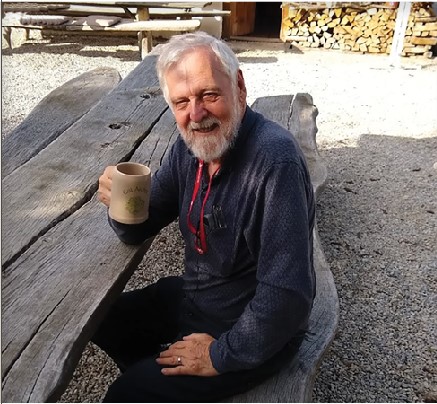
PAC World: You are still working. What keeps you going?
H.K.: The technical challenges may be the largest part of it, but my friendships within the community are very important too.
PAC World: How do you balance your active professional life with your family life?
J.B.: I don’t think I do, any more. When my children were young, I’d go to work early so I could come home early and be with them before they went to bed. But now none of them are living with me, I think I’m not balanced in that sense.
PAC World: What do you consider your greatest personal achievement?
H.K.: I had to ask my wife what she thought about this question. Her answer was that I seem to take pleasure in the achievements and growth of my various students and interns over the years. That seems right. That does not mean I am not proud of my children, of course. But they’re still in school, and have yet to make much impact on the world.
PAC World: What do you like to do when you are not working?
H.K.: I have kept electronics as a hobby, and I have a collection of radios that are mostly older than me, and need to be made functional. They are part of my retirement plan.
PAC World: You travel a lot all over the world. Do you have a favorite place?
H.K.: I used to think Japan was my favorite foreign country to visit. I have visited there many times. The people are friendly and helpful, and the place is just civilized. But last year I was in Ireland for the first time, and I loved it! Given a choice of visiting only one, it would have to be Ireland.
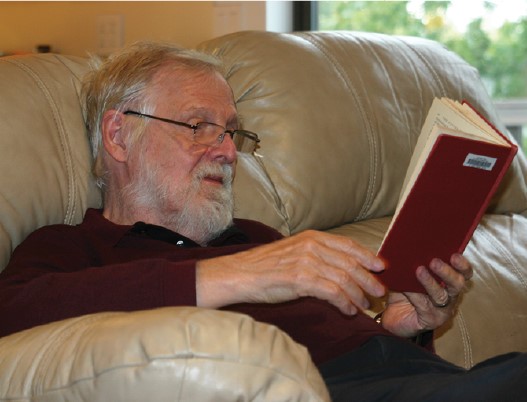
PAC World: Do you have favorite music?
H.K.: I like many kinds of music. Choral music appeals sometimes (I was a tenor in the Caltech Glee Club) but at other times I’d rather listen to bluegrass. Then there’s Jane Olivor, best on headphones. Or Queen. I have broad tastes, but dated, I guess.
PAC World: Your favorite form of entertainment?
H.K.: I used to enjoy Disneyland when I lived in California. I read a lot. Percy Bridgman makes me think, and his books are for quiet afternoons. I treasure my copy of Carnap’s Philosophical Foundations of Physics, though it’s easier to dip into the pdf version. Most recently I’ve been re-reading Terry Pratchett, another favorite of mine.
PAC World: What is your favorite food?
H.K.: Indian curry, various. Closely followed by Sichuan-style Chinese food.
PAC World: Do you have a motto?
H.K.: I have had one since I was in school in England. It is in Latin. But you wouldn’t want to print it in case someone translated it.

PAC World: Is there anything you would like to say to the young PAC engineers around the world?
H.K.: Yes. We need you! Our profession will be relying on your skills for its growth.
PAC World: Is there anything that we didn’t ask that you think can help our readers better understand you?
H.K.: Maybe one thing: you never asked if I am having fun doing this! The answer would be a resounding yes! I think I have been enormously lucky to have a career so full of curious and interesting things to do.
Biography:
Harold Kirkham has been interested in both measurements and electric power since he was an undergraduate. He obtained his MSc from Aston University and PhD from Drexel University in Philadelphia, PA.
He worked at NASA’s Jet Propulsion Laboratory in Pasadena, CA, for many years, on a variety of projects to do with power or measurement. He has been at the Pacific Northwest National Laboratory since 2009. His chief interest now is the theoretical side of measurement.

He has written many papers and reports, and one book. He was a member of the working group that wrote the IEEE PMU standard C37-118.1-2011 and Chair of the IEEE PES Instrumentation and Measurements Committee.
He is a Life Fellow of IEEE and an IEEE Distinguished Lecturer.



